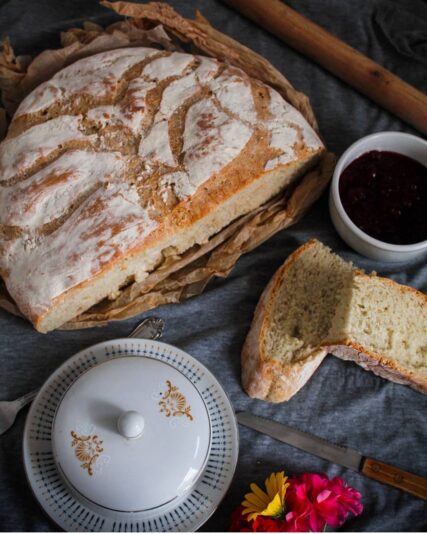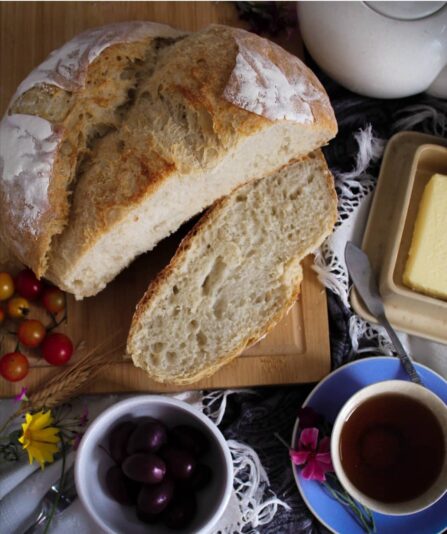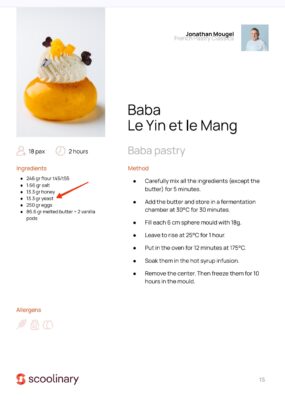Respuestas creadas en el foro
-
Level:
Scoolinary Team
Hola Vero.
En un país tropical como El Salvador, donde hace calor y humedad casi todo el año, la duración de las donas depende mucho de cómo estén decoradas y almacenadas:
Donuts sin glasear:
▪️A temperatura ambiente (cubiertas en un recipiente hermético o envueltas en film) duran 1 a 2 días antes de volverse secas o duras.
▪️En refrigeración pueden aguantar 3 a 4 días, aunque se pueden resecar un poco, por lo que conviene calentarlas unos segundos antes de consumir.
Donuts glaseadas (clásico con azúcar glas o glaseado simple):
▪️A temperatura ambiente: 1 día. El glaseado puede empezar a sudar y derretirse con el calor y la humedad.
2En refrigeración: 2 a 3 días, en un recipiente hermético. El glaseado puede cambiar textura, pero se conserva mejor.
Donuts decoradas con fruta fresca o glaseados a base de pulpa de fruta:
▪️A temperatura ambiente no es recomendable dejarlas más de 4 a 6 horas, porque la fruta se oxida, suelta humedad y puede fermentar.
▪️En refrigeración duran 1 día como máximo, ya que la fruta sigue liberando jugos y afecta la textura de la dona.
Consejos para almacenarlas mejor:
▪️Guárdalas en un recipiente hermético o una caja bien cerrada, preferiblemente en un lugar fresco.
▪️Si el clima está muy caliente, es mejor refrigerarlas, pero antes de comer puedes calentarlas 5 a 8 segundos en microondas o dejar que tomen temperatura ambiente para que no estén duras.
▪️Evita apilarlas para que no se peguen los glaseados.
Espero que sea de ayuda esta información y si puedes nos compartes más adelante que opción fue la que mejor te funcionó para conservar tus dónuts.
Saludos.
-
Level:
Scoolinary Team
Hi Shanon,
Thank you for your message and for sharing your situation.Let me explain:
Yes, you can make your sourdough starter with regular wheat flour (refined flour). In fact, I bake sourdough bread myself, and I often feed my starter with low-protein flour since I don’t always have bread flour on hand and I’ve had great results. (I’m attaching some photos of my breads so you can see the outcome.)
Ideally, when making a sourdough starter, it’s best to work with less refined flours because they provide more nutrients and natural microorganisms that help the starter develop better. But if all you have is regular flour, you can definitely use it. Just keep in mind that it might take a little longer to become active, and you may need to refresh it a few more times to strengthen it.
As for the bread itself, if you use only all-purpose flour (regular wheat flour) instead of bread flour or 86% extraction flour, the texture will be a bit different. Bread flour has a higher protein (gluten) content, which helps develop a better structure and elasticity in the dough, resulting in a bread with more volume and an airy crumb. With regular flour, the bread will be denser and have a tighter crumb but it can still taste great.To adjust the recipe, I suggest:
-Use your regular wheat flour for both the sourdough starter and the bread dough.
-Increase the kneading time a little to develop the available gluten as much as possible.
-Slightly reduce the hydration (amount of water) if you notice the dough is too soft, since regular flour absorbs less water than bread flour.
-Do longer, well-controlled fermentations to improve the texture.And in the case of buckwheat bread, since it doesn’t contain gluten, you’ll need to rely more on fermentation and shaping technique to get a good result.
I’d recommend starting with a small test batch of your breads using the flours you have available , that way you’ll see if you can achieve the result you’re looking for.I hope this information is helpful, and if you have any other questions, I’m here to help.
Best regards.
-
Sussan Estela Olaya
Administradormayo 15, 2025 en 20:54 en respuesta a Elena Adell’s cheesecake size and cooldown timeLevel:Scoolinary Team
Hi Miguel.
Welcome to the community! We’re so happy to have you here. Don’t worry at all about asking questions , every question is welcome, and you’re actually paying attention to some very important details. I’m really glad to help you out.
Here are some thoughts on your doubts:
1. Cheesecake height:
If you’re using an 18 cm mold and your cheesecake came out taller, it could be that your mold has higher sides than Elena’s, or that the batter expanded more upward due to less evaporation. Another possible reason is the mixing: if some air was incorporated into the batter during preparation, that can also cause it to rise more.
2. Pale color of the cheesecake:
The recipe calls for 25 minutes at 170°C, which is a gentle bake intended to give the cheesecake a smooth and creamy texture — not a golden top. If Chef Elena’s cheesecake looks darker in the video, it could be for several reasons:
Her oven might have a stronger top heat function.
She may have baked it for a few minutes longer.
A helpful tip: Make sure to preheat your oven for at least 20–25 minutes before baking. That way, you’re sure it’s at the correct temperature, which leads to a better and more even result.
If you’d like a more golden top, you can bake it for an extra 5–10 minutes or slightly increase the temperature during the last few minutes — just be sure to keep an eye on it so it doesn’t overbake.
3. Chilling overnight:
Yes! It’s highly recommended to let the cheesecake rest in the fridge for at least 6 hours — ideally overnight. This allows the texture to fully set, the flavors to develop, and makes it easier to slice cleanly. Even though it’s not included in the original recipe, it’s a common and helpful step for most cheesecakes. Feel free to do it!
You’re doing a great job, Miguel. Asking questions, observing, and experimenting are key to learning in pastry. So feel free to ask anything you need that’s exactly what I’m here for.
Big hug, and I hope you keep enjoying the learning process here at Scoolinary!
Best wishes.
-
Sussan Estela Olaya
Administradormayo 15, 2025 en 20:39 en respuesta a Sustituir azucar invertido y pctina nhLevel:Scoolinary Team
Hola Ana.
Gracias por tu consulta. En efecto, en muchos de los interiores que hace el chef Antonio Bachour, se utilizan pequeñas cantidades de azúcar invertido y pectina NH para lograr una textura suave y una buena conservación.
Estos ingredientes se pueden reemplazar y a continuación te doy algunas alternativas:
Azúcar invertido: Puedes reemplazarlo por miel suave o jarabe de glucosa en la misma proporción. Ambos ayudan a mantener la humedad y evitan la cristalización del azúcar, aunque no tienen exactamente el mismo poder anticristalizante.
Pectina NH: Es una pectina termorreversible, ideal para interiores que luego se recalientan. Si no la tienes, puedes usar gelatina en polvo como alternativa básica, aunque la textura será más parecida a un gel firme que a una confitura elástica. Una guía general sería usar entre 6 y 8 g de gelatina por cada 500 g de preparación.
En el caso que quieras hacer el azúcar invertido en casa, te comparto una receta casera (nappage):
Ingredientes:
150 g de azúcar
150 g de agua
7 g de gelatina en polvo
35 g de agua fría (para hidratar la gelatina)
Preparación:
1. Hidrata la gelatina en los 35 g de agua fría.
2. Hierve los 150 g de agua con el azúcar hasta formar un almíbar.
3. Cuando el almíbar baje a unos 60 °C, añade la gelatina hidratada y mezcla bien.
4. Deja enfriar y gelificar.
Uso:
Antes de aplicarlo, calienta una pequeña porción en el microondas para que vuelva a estar líquido y aplica con pincel sobre la superficie del pastel. Puedes guardar el sobrante en la nevera por varios días.
¡Espero que estas alternativas te sirvan y te animen a seguir experimentando
en la cocina!
Saludos.
-
Sussan Estela Olaya
Administradormayo 15, 2025 en 20:32 en respuesta a Scones with Mascarpone and blueberryLevel:Scoolinary Team
Hi Angela.
Valrhona’s Absolut Cristal Neutral Glaze is a professional shiny glaze designed to give a mirror-like finish to chilled desserts. This type of glaze has a gelatin-based formula and is stabilized to remain fluid and glossy at refrigeration temperatures (4°C / 39°F).
While nappage is typically a ready-to-use product, you can also make it at home.
Here’s a simple recipe:
Ingredients:
150 g sugar
150 g water
7 g powdered gelatin
35 g cold water (for blooming the gelatin)
Preparation:
To make this cake glaze or nappage, start by blooming the gelatin in the cold water.
Meanwhile, bring the sugar and water to a boil to create a simple syrup. Once it reaches a boil, let it cool down to about 60°C (140°F), then add the bloomed gelatin and stir until fully dissolved.
Allow the mixture to cool and set.
When you’re ready to use it, gently reheat the glaze in the microwave until it becomes liquid again. Then, use a pastry brush to apply a shiny coat over your cake. Any leftover nappage can be stored in the refrigerator for a few days.
Best regards.
-
Sussan Estela Olaya
Administradormayo 15, 2025 en 20:27 en respuesta a sourdough bread, fridge fermentation on the fridgeLevel:Scoolinary Team
Hi Stravos!
Yes, it’s important to cover your dough during cold fermentation in the refrigerator, especially if it will be there for 24 hours.Covering it prevents the surface from drying out and forming a crust, which can negatively affect the rise and the final look of your bread.
You can cover it with plastic wrap, a tight-fitting lid if it’s in a container, or even a damp cloth (though that’s less effective for longer fermentations). If you’re using a banneton, the best option is to place it inside a large plastic bag or in a container with a lid.
Happy fermenting, and enjoy your bread!
Best regards
-
Level:
Scoolinary Team
Hi Dani!.
Thanks for your question. To extend the shelf life of shortbread and soft cookies,especially if they’re going to be distributed in supermarkets it’s important to consider both the production process and the use of appropriate preservatives.
Because of their fat and moisture content, these types of cookies are more prone to rancidity and mold growth. A safe and commonly used solution in the industry is to add preservatives like potassium sorbate or calcium propionate, which help prevent the growth of mold and yeast. These are used in small amounts and are approved for use in food.
There are also other strategies you can apply to help prolong shelf life without affecting the flavor or texture, such as:
- Reducing the water content (water activity) in the recipe
- Packaging them in a modified atmosphere (like with nitrogen), or using packaging materials with strong barriers against moisture and oxygen
- Adjusting the pH of the dough, since a slightly acidic environment also helps inhibit microbial growth
In short, using a chemical preservative is necessary to extend the product’s life, but packaging, post-baking handling, and storage are equally important. The combination of these factors will help you achieve a more stable and safe product for commercial distribution.
I hope this information helps!
Best regards. -
Sussan Estela Olaya
Administradormayo 14, 2025 en 21:14 en respuesta a How much do I add the yeast?Level:Scoolinary Team
-
Sussan Estela Olaya
Administradormayo 16, 2025 en 02:48 en respuesta a Duda del curso Croissants y Bollería – Antonio BachourLevel:Scoolinary Team
Genial Wilfredo, ya me cuentas que tal te va con tus croissants.🙌🏻
Saludos.
-
Sussan Estela Olaya
Administradormayo 16, 2025 en 02:22 en respuesta a Scones with Mascarpone and blueberryLevel:Scoolinary Team
Hi Angela.
I’m glad to hear the information I provided was helpful. If you have any other questions, I’m here to help.
Best regards.
-
Sussan Estela Olaya
Administradormayo 15, 2025 en 20:22 en respuesta a Black ink/food coloring for laminated doughLevel:Scoolinary Team
Hi Salma!
No worries at all,I’m glad you saw the message.
Yes, you can absolutely use both ascorbic acid and soy lecithin together. They work in a complementary way: ascorbic acid helps strengthen the gluten and improve the dough structure, while lecithin acts as an emulsifier, helping retain moisture and extend freshness. Just be sure not to exceed the recommended dosage (between 0.1% and 0.3% of the total flour weight).
As for storage, keeping croissants in an airtight container in the fridge isn’t ideal, as the cold tends to dry out and harden laminated doughs. However, if that’s your only option and you plan to reheat them before serving, it can work—just make sure to:
- Let them cool completely before storing to avoid condensation.
- Wrap them in parchment paper or plastic wrap before placing them in the container.
- Reheat them in a preheated oven at 160–170°C (320–340°F) for a few minutes to bring back some of the crispness.
An even better option—if you’re not eating them within 1–2 days—is to freeze them once cooled. They freeze very well, and if you reheat them straight from frozen, they come out almost like freshly baked.
Hope this helps you keep your croissants delicious for longer!
Warm regards,
Sussan. -
Sussan Estela Olaya
Administradormayo 15, 2025 en 14:38 en respuesta a Piping tecniques and frosting(Cake design)Level:Scoolinary Team
Hi Mary.
I have news! The content team has informed me that they have a course on this topic scheduled for September.✨🙌🏻✨
Best regards.
-
Sussan Estela Olaya
Administradormayo 15, 2025 en 03:05 en respuesta a Piping tecniques and frosting(Cake design)Level:Scoolinary Team
Hi Mary.
Thank you for suggesting new courses to us.
Best regards!
-
Sussan Estela Olaya
Administradormayo 15, 2025 en 03:18 en respuesta a Adell’s cheesecake requires what type of oven to get the perfect results?Level:Scoolinary Team
Hi Salma!
I’m glad to hear the previous information was helpful.
About the Japanese cotton cheesecake ,we understand it can be tricky, especially if your oven fan can’t be turned off, since this type of recipe really needs gentle, still heat to bake properly.Here are a few tips that might help:
1. Protect the cake from direct airflow:You can loosely cover the pan with aluminum foil (leaving room for the cake to rise), or place a baking tray on a higher rack to block the hot air from hitting the surface directly.
2. Lower the temperature slightly:Since the fan makes the oven more efficient, it’s a good idea to reduce the baking temperature by about 15–20°C compared to what the recipe says, and extend the baking time a bit. This helps prevent the outside from cooking too fast while the inside remains underdone.
3. Avoid opening the oven during baking:Sudden changes in temperature or humidity can really affect this kind of delicate cake.
Hopefully, with these adjustments, you’ll get a better texture even with the fan running.Let us know how it goes with these changes!
Warm regards.
-
Level:
Scoolinary Team
Hola Dali.
Ya nos cuentas que tal salen tus pruebas con los discos de merengue y si gustas nos muestras una foto de tu resultado. Ya sabes que si tienes alguna otra consulta aquí estoy para ayudarte.
Saludos.






